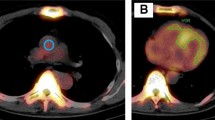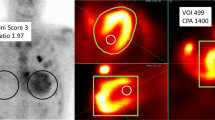Abstract
Background
Quantitative uptake of Technetium 99 m-pyrophosphate (TcPYP) is sensitive and specific for diagnosing transthyretin cardiac amyloidosis (ATTR). We sought to examine the association between TcPYP uptake intensity and echocardiographic measures of disease severity and clinical outcomes.
Methods and Results
A retrospective analysis was performed of 75 patients who underwent TcPYP scintigraphy. Planar images were evaluated semiquantitatively and using heart-to-contralateral lung (H/CL) ratio. The associations between H/CL ratio and echocardiographic parameters and outcomes were evaluated using linear regression and Cox models, respectively. There were 48 patients diagnosed with ATTR with mean H/CL ratio 1.58 ± 0.22 (vs 1.08 ± 0.09 if semiquantitative score = 0). The H/CL ratio was not associated with any measured echocardiographic parameter. Both semiquantitative uptake grade and H/CL ratio were associated with all-cause mortality (P = 0.009 and 0.007, respectively) and all-cause mortality or heart failure hospitalization (P = 0.001 and 0.020, respectively); however, neither were associated with outcomes when limited to patients with confirmed ATTR (P = 0.18 and 0.465, respectively).
Conclusion
In patients with suspected ATTR, quantitative and semiquantitative uptake intensity of TcPYP is associated with all-cause mortality as well as all-cause mortality or heart failure hospitalization. However, in those with confirmed ATTR, there is no association with echocardiographic disease severity or outcomes.




Similar content being viewed by others
Abbreviations
- AL:
-
Light chain amyloidosis
- ATTR:
-
Transthyretin amyloidosis
- H/CL:
-
Heart-to-contralateral lung
- TcPYP:
-
99 m technetium pyrophosphate
- CMR:
-
Cardiac magnetic resonance imaging
- SPECT:
-
Single-photon emission computed tomography
- LV:
-
Left ventricular
- RV:
-
Right ventricular
- LS:
-
Longitudinal strain
References
Vranian MN, Sperry BW, Valent J, Hanna M. Emerging advances in the management of cardiac amyloidosis. Curr Cardiol Rep. 2015;17:100.
Sperry BW, Vranian MN, Hachamovitch R, Joshi H, Ikram A, Phelan D, et al. Subtype-specific interactions and prognosis in cardiac amyloidosis. J Am Heart Assoc. 2016;4:e002877.
Bokhari S, Castano A, Pozniakoff T, Deslisle S, Latif F, Maurer MS. (99 m)Tc-pyrophosphate scintigraphy for differentiating light-chain cardiac amyloidosis from the transthyretin-related familial and senile cardiac amyloidoses. Circ Cardiovasc Imaging. 2013;6:195–201.
Rapezzi C, Quarta CC, Guidalotti PL, Longhi S, Pettinato C, Leone O, et al. Usefulness and limitations of 99 mTc-3,3-diphosphono-1,2-propanodicarboxylic acid scintigraphy in the aetiological diagnosis of amyloidotic cardiomyopathy. Eur J Nucl Med Mol Imaging. 2011;38:470–8.
Glaudemans AW, van Rheenen RW, van den Berg MP, Noordzij W, Koole M, Blokzijl H, et al. Bone scintigraphy with (99 m)technetium-hydroxymethylene diphosphonate allows early diagnosis of cardiac involvement in patients with transthyretin-derived systemic amyloidosis. Amyloid. 2014;21:35–44.
Perugini E, Guidalotti PL, Salvi F, Cooke RM, Pettinato C, Riva L, et al. Noninvasive etiologic diagnosis of cardiac amyloidosis using 99 mTc-3,3-diphosphono-1,2-propanodicarboxylic acid scintigraphy. J Am Coll Cardiol. 2005;46:1076–84.
Study E. ClinicalTrials.gov, Identifier: NCT02319005.
Gillmore JD, Maurer MS, Falk RH, Merlini G, Damy T, Dispenzieri A, et al. Nonbiopsy diagnosis of cardiac transthyretin amyloidosis. Circulation. 2016;133:2404–12.
Harb SC, Haq M, Flood K, Guerrieri A, Passerell W, Jaber WA, et al. National patterns in imaging utilization for diagnosis of cardiac amyloidosis: A focus on Tc99 m-pyrophosphate scintigraphy. J Nucl Cardiol. 2016. doi:10.1007/s12350-016-0478-3.
Dorbala S, Bokhari S, Miller E, Bullock-Palmer R, Soman P, Thompson R. American Society of Nuclear Cardiology. Practice Points: 99 m Technetium-Pyrophosphate Imaging for Transthyretin Cardiac Amyloidosis.
Kristen AV, Scherer K, Buss S, Aus Dem Siepen F, Haufe S, Bauer R, et al. Noninvasive risk stratification of patients with transthyretin amyloidosis. JACC Cardiovasc Imaging. 2014;7:502–10.
Rapezzi C, Quarta CC, Guidalotti PL, Pettinato C, Fanti S, Leone O, et al. Role of (99m)Tc-DPD scintigraphy in diagnosis and prognosis of hereditary transthyretin-related cardiac amyloidosis. JACC Cardiovasc Imaging. 2011;4:659–70.
Phelan D, Collier P, Thavendiranathan P, Popovic ZB, Hanna M, Plana JC, et al. Relative apical sparing of longitudinal strain using two-dimensional speckle-tracking echocardiography is both sensitive and specific for the diagnosis of cardiac amyloidosis. Heart. 2012;98:1442–8.
Austin BA, Tang WH, Rodriguez ER, Tan C, Flamm SD, Taylor DO, et al. Delayed hyper-enhancement magnetic resonance imaging provides incremental diagnostic and prognostic utility in suspected cardiac amyloidosis. JACC Cardiovasc Imaging. 2009;2:1369–77.
Lang RM, Badano LP, Mor-Avi V, Afilalo J, Armstrong A, Ernande L, et al. Recommendations for cardiac chamber quantification by echocardiography in adults: An update from the American Society of Echocardiography and the European Association of Cardiovascular Imaging. J Am Soc Echocardiogr. 2015;28(1–39):e14.
Hutt DF, Quigley AM, Page J, Hall ML, Burniston M, Gopaul D, et al. Utility and limitations of 3,3-diphosphono-1,2-propanodicarboxylic acid scintigraphy in systemic amyloidosis. Eur Heart J Cardiovasc Imaging. 2014;15:1289–98.
Senapati A, Sperry BW, Grodin JL, Kusunose K, Thavendiranathan P, Jaber W, et al. Prognostic implication of relative regional strain ratio in cardiac amyloidosis. Heart. 2016;102:748–54.
Castano A, Haq M, Narotsky DL, Goldsmith J, Weinberg RL, Morgenstern R, et al. Multicenter study of planar technetium 99m pyrophosphate cardiac imaging: Predicting survival for patients with ATTR cardiac amyloidosis. JAMA Cardiol. 2016;1:880–9.
Disclosures
The authors report no conflicts of interest related to this manuscript.
Author information
Authors and Affiliations
Corresponding author
Additional information
The authors of this article have provided a PowerPoint file, available for download at SpringerLink, which summarises the contents of the paper and is free for re-use at meetings and presentations. Search for the article DOI on www.SpringerLink.com.
Electronic supplementary material
Below is the link to the electronic supplementary material.
Rights and permissions
About this article
Cite this article
Vranian, M.N., Sperry, B.W., Hanna, M. et al. Technetium pyrophosphate uptake in transthyretin cardiac amyloidosis: Associations with echocardiographic disease severity and outcomes. J. Nucl. Cardiol. 25, 1247–1256 (2018). https://doi.org/10.1007/s12350-016-0768-9
Received:
Accepted:
Published:
Issue Date:
DOI: https://doi.org/10.1007/s12350-016-0768-9




